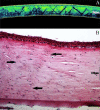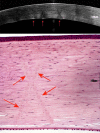The architecture of corneal stromal striae on optical coherence tomography and histology in an animal model and in humans
- PMID: 33199775
- PMCID: PMC7670407
- DOI: 10.1038/s41598-020-76963-w
The architecture of corneal stromal striae on optical coherence tomography and histology in an animal model and in humans
Abstract
The purpose of this study was to use a portable optical coherence tomography (OCT) for characterization of corneal stromal striae (CSS) in an ovine animal model and human corneas with histological correlation, in order to evaluate their architectural pattern by image analysis. Forty-six eyes from female adult sheep (older than 2 years), and 12 human corneas, were included in our study. The eyes were examined in situ by a portable OCT, without enucleation. All OCT scans were performed immediately after death, and then the eyes were delivered to a qualified histology laboratory. In the ovine animal model, CSS were detected with OCT in 89.1% (41/46) of individual scans and in 93.4% (43/46) of histological slices. In human corneas, CSS were found in 58.3% (7/12) of cases. In both corneal types, CSS appeared as "V"- or "X"-shaped structures, with very similar angle values of 70.8° ± 4° on OCT images and 71° ± 4° on histological slices (p ≤ 0.01). Data analysis demonstrated an excellent degree of reproducibility and inter-rater reliability of measurements (p < 0.001). The present study demonstrated that by using a portable OCT device, CSS can be visualized in ovine and human corneas. This finding suggests their generalized presence in various mammals. The frequent observation, close to 60%, of such collagen texture in the corneal stroma, similar to a 'truss bridge' design, permits to presume that it plays an important structural role, aimed to distribute tensile and compressive forces in various directions, conferring resilience properties to the cornea.
Conflict of interest statement
The authors declare no competing interests.
Figures



Similar articles
-
Corneal thickness of eyes of healthy goats, sheep, and alpacas manually measured by use of a portable spectral-domain optical coherence tomography device.Am J Vet Res. 2017 Jan;78(1):80-84. doi: 10.2460/ajvr.78.1.80. Am J Vet Res. 2017. PMID: 28029294
-
Morphological analysis of corneal findings modifications after death: A preliminary OCT study on an animal model.Exp Eye Res. 2018 Apr;169:20-27. doi: 10.1016/j.exer.2018.01.013. Epub 2018 Jan 31. Exp Eye Res. 2018. PMID: 29360448
-
Full-field optical coherence tomography of human donor and pathological corneas.Curr Eye Res. 2015 May;40(5):526-34. doi: 10.3109/02713683.2014.935444. Epub 2014 Sep 24. Curr Eye Res. 2015. PMID: 25251769
-
Manual corneal thickness measurements of healthy equine eyes using a portable spectral-domain optical coherence tomography device.Equine Vet J. 2014 Sep;46(5):631-4. doi: 10.1111/evj.12198. Epub 2013 Dec 9. Equine Vet J. 2014. PMID: 24131285
-
Post-Mortem Corneal Thickness Measurements with a Portable Optical Coherence Tomography System: a Reliability Study.Sci Rep. 2016 Jul 26;6:30428. doi: 10.1038/srep30428. Sci Rep. 2016. PMID: 27457021 Free PMC article.
Cited by
-
The Influence of Eyelid Position and Environmental Conditions on the Corneal Changes in Early Postmortem Interval: A Prospective, Multicentric OCT Study.Diagnostics (Basel). 2022 Sep 7;12(9):2169. doi: 10.3390/diagnostics12092169. Diagnostics (Basel). 2022. PMID: 36140570 Free PMC article.
-
Analysis of Cryopreservation Protocols and Their Harmful Effects on the Endothelial Integrity of Human Corneas.Int J Mol Sci. 2021 Nov 22;22(22):12564. doi: 10.3390/ijms222212564. Int J Mol Sci. 2021. PMID: 34830446 Free PMC article.
-
High-Resolution Optical Coherence Tomography Angiography Characteristics of Limbal Stem Cell Deficiency.Diagnostics (Basel). 2021 Jun 21;11(6):1130. doi: 10.3390/diagnostics11061130. Diagnostics (Basel). 2021. PMID: 34205702 Free PMC article.
-
Comparative Histology of the Cornea and Palisades of Vogt in the Different Wild Ruminants (Bovidae, Camelidae, Cervidae, Giraffidae, Tragulidae).Animals (Basel). 2022 Nov 17;12(22):3188. doi: 10.3390/ani12223188. Animals (Basel). 2022. PMID: 36428415 Free PMC article.
-
Postmortem Ocular Findings in the Optical Coherence Tomography Era: A Proof of Concept Study Based on Six Forensic Cases.Diagnostics (Basel). 2021 Feb 28;11(3):413. doi: 10.3390/diagnostics11030413. Diagnostics (Basel). 2021. PMID: 33670928 Free PMC article.
References
-
- Nioi M, Napoli PE, Paribello F, Demontis R, De Giorgio F, Porru E, Fossarello M, d'Aloja E. Use of optical coherence tomography on detection of postmortem ocular findings: Pilot data from two cases. J. Integr. OMICS. 2018;8(1):5–7. doi: 10.5584/jiomics.v8i1.226. - DOI
MeSH terms
LinkOut - more resources
Full Text Sources

